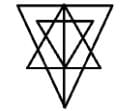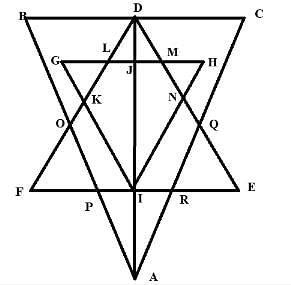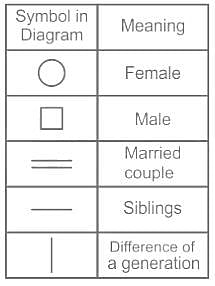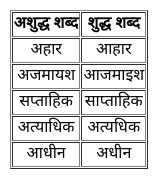DSSSB PRT Mock Test - 4 - DSSSB TGT/PGT/PRT MCQ
30 Questions MCQ Test DSSSB PRT Mock Test Series 2024 - DSSSB PRT Mock Test - 4
P is father of S. Q is mother of R. R is the mother of S. How is Q is related to S?
| 1 Crore+ students have signed up on EduRev. Have you? Download the App |
Which answer figure will complete the pattern in the question figure?


Directions to Solve
Each of the following questions has a group. Find out which one of the given alternatives will be another member of the group or of that class.
Question -
Root, Stem, Branch
In this questions, a number series is given with one term missing. Choose the correct alternative that will continue the same pattern and fill in the black spaces.
Q. 34, 18, 10, 6, 4, (___)
Which is not a connective tissue in the following given options?
What is the Gross Merchandise Value (GMV) achieved by the Government e-Marketplace (GeM)?
Which country hosted the World HRD Congress where Startek received prestigious accolades?
The combined amount spent on 30 books and 120 notebooks is Rs. 15,000. If the price of each book is Rs. 400, what is the price of each notebook?
Six friends have an average height of 172 cm. A boy with height 152 cm leaves the group. What is the new average height of the group?
The H.C.F. of two numbers is 96 and their L.C.M. is 1296. If one of the number is 864, the other is
Fill in the blanks with the correct modal verb.
You _________ smoke near children.
Fill in the blank with the correct option.
It almost always rains in Seattle. The sun ________ shines there.
Choose the correct meaning of the given proverb/idiom.
To end in smoke
Directions: The passage below is accompanied by a set of questions. Choose the best answer to each question.
We've all heard about the search for life on other planets, but what about looking on other moons?
In a paper published June 13 in The Astrophysical Journal, researchers at the University of California, Riverside and the University of Southern Queensland have identified more than 100 giant planets that potentially host moons capable of supporting life. Their work will guide the design of future telescopes that can detect these potential moons and look for tell-tale signs of life, called 'biosignatures', in their atmospheres.
Since the 2009 launch of NASA's Kepler telescope, scientists have identified thousands of planets outside our solar system, which are called exoplanets. A primary goal of the Kepler mission is to identify planets that are in the habitable zones of their stars, meaning they're neither too hot nor too cold for liquid water – and potentially life – to exist.
Terrestrial (rocky) planets are prime targets in the quest to find life because some of them might be geologically and atmospherically similar to Earth. Another place to look is the many gas giants identified during the Kepler mission. While not a candidate for life themselves, Jupiter-like planets in the habitable zone may harbour rocky moons, called exomoons, that could sustain life.
''There are currently 175 known moons orbiting the eight planets in our solar system. While most of these moons orbit Saturn and Jupiter, which are outside the Sun's habitable zone, that may not be the case in other solar systems,'' said Stephen Kane, an associate professor of planetary astrophysics and a member of the UCR's Alternative Earths Astrobiology Center. ''Including rocky exomoons in our search for life in space will greatly expand the places we can look.''
The researchers identified 121 giant planets that have orbits within the habitable zones of their stars. At more than three times the radii of the Earth, these gaseous planets are less common than terrestrial planets, but each is expected to host several large moons.
Scientists have speculated that exomoons might provide a favourable environment for life, perhaps even better than Earth. That's because they receive energy not only from their star, but also from radiation reflected from their planet. Until now, no exomoons have been confirmed
''Now that we have created a database of the known giant planets in the habitable zone of their star, observations of the best candidates for hosting potential exomoons will be made to help refine the expected exomoon properties. Our follow-up studies will help inform future telescope design so that we can detect these moons, study their properties, and look for signs of life,'' said Michelle Hill, an undergraduate student at the University of Southern Queensland who is working with Kane and will join UCR's graduate program in the fall.
Q. Which of the following statements can be inferred from the information provided in the passage?
Directions: The passage below is accompanied by a set of questions. Choose the best answer to each question.
We've all heard about the search for life on other planets, but what about looking on other moons?
In a paper published June 13 in The Astrophysical Journal, researchers at the University of California, Riverside and the University of Southern Queensland have identified more than 100 giant planets that potentially host moons capable of supporting life. Their work will guide the design of future telescopes that can detect these potential moons and look for tell-tale signs of life, called 'biosignatures', in their atmospheres.
Since the 2009 launch of NASA's Kepler telescope, scientists have identified thousands of planets outside our solar system, which are called exoplanets. A primary goal of the Kepler mission is to identify planets that are in the habitable zones of their stars, meaning they're neither too hot nor too cold for liquid water – and potentially life – to exist.
Terrestrial (rocky) planets are prime targets in the quest to find life because some of them might be geologically and atmospherically similar to Earth. Another place to look is the many gas giants identified during the Kepler mission. While not a candidate for life themselves, Jupiter-like planets in the habitable zone may harbour rocky moons, called exomoons, that could sustain life.
''There are currently 175 known moons orbiting the eight planets in our solar system. While most of these moons orbit Saturn and Jupiter, which are outside the Sun's habitable zone, that may not be the case in other solar systems,'' said Stephen Kane, an associate professor of planetary astrophysics and a member of the UCR's Alternative Earths Astrobiology Center. ''Including rocky exomoons in our search for life in space will greatly expand the places we can look.''
The researchers identified 121 giant planets that have orbits within the habitable zones of their stars. At more than three times the radii of the Earth, these gaseous planets are less common than terrestrial planets, but each is expected to host several large moons.
Scientists have speculated that exomoons might provide a favourable environment for life, perhaps even better than Earth. That's because they receive energy not only from their star, but also from radiation reflected from their planet. Until now, no exomoons have been confirmed
''Now that we have created a database of the known giant planets in the habitable zone of their star, observations of the best candidates for hosting potential exomoons will be made to help refine the expected exomoon properties. Our follow-up studies will help inform future telescope design so that we can detect these moons, study their properties, and look for signs of life,'' said Michelle Hill, an undergraduate student at the University of Southern Queensland who is working with Kane and will join UCR's graduate program in the fall.
Q. The author of the passage is most likely to agree with which of the following statements?
गरमी के इस प्रकोप से अपने आपको बचाने के लिए मनुष्य ने उपाय खोज निकाले हैं। साधारण आय वाले घरों में बिजली के पंखे चल रहे हैं, जो नर-नारियों की पसीने से रक्षा करते हैं। अमीरों के यहाँ वातानुकूलन यंत्र लगे हैं। समर्थ जन गरमी से बचने के लिए पहाड़ी स्थलों पर चले जाते हैं और ज्येष्ठ की तपती दोपहरी पहाड़ की ठंडी हवाओं में बिताते हैं। प्यास बुझाने के लिए शीतल पेय है बर्फ और बर्फ से बने पदार्थ ग्रीष्म के शत्रु और लोगों के लिए वरदान हैं।
प्रश्न. समर्थ जन गरमी से बचने के लिए कहाँ चले जाते हैं?
Which of the following is /are an example of performing art?
I. Magic
II. Spoken words
III. Circus art
In which of the following ways drama is practiced?
I. Acting with expressions.
II. Expressing feelings and ideas through Mask.
III. Narrating the story or an experience.
I. Proper execution of the mid-day meal program
II. Regular practice of yoga, physical education, and health education.






















